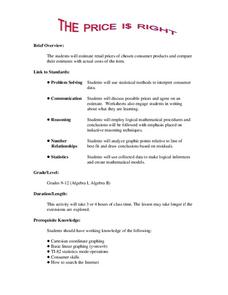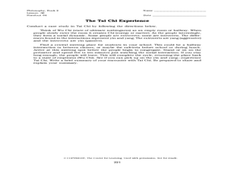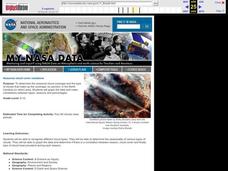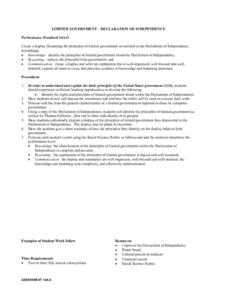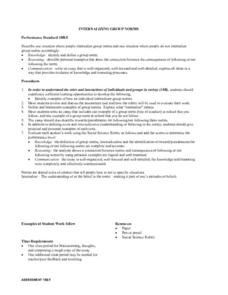Curated OER
Fahrenheit vs Celsius
Students construct a thermometer and convert Fahrenheit temperature into Celsius temperature. In small groups, they construct a thermometer, write a paragraph describing how to make a thermometer, and convert temperatures.
Curated OER
Mushrooms Can Save the World
Middle schoolers use mushrooms to solve problems. In this environmental lesson, students study how fungi have been used to combat environmental problems. Middle schoolers design strategies that employ mushrooms to combat other...
Curated OER
The Price Is Right
Students create a list of products with estimated prices. For this algebra lesson, students learn to write equations using variables. They match their created list with that of actual products and compare their prices,
Curated OER
Using Connectors: Because and Though
In this using connectors: because and though learning exercise, students red the explanations and examples for using these two conjunctions, then interactively complete 20 sentences using the correct words or punctuation, with...
Curated OER
Tai Chi
Students explore the concept of yin and yang. In this Tai Chi instructional activity, students create a working definition of yin and yang as they read about its role in Eastern philosophy. Students also discuss the relationship between...
Curated OER
Trouble in the Troposphere
Learners create graphs using NASA data, compare ozone levels of several U.S. cities, analyze and evaluate the data and predict trends based on the data, and discuss and describe how human activities have modified Earth's air quality.
Curated OER
Seasonal Cloud Cover Variations
Students recognize different cloud types. They determine the seaonality of various types of clouds. They graph the data and determine if a correlation exists between season, cloud cover and type of clouds most prevalent during each season.
Curated OER
Visual Opacity
Students discover the difference between transparent, translucent and opaque. They use those descriptions to classify clouds. They create a presentation in which they show the different types of clouds with their descriptions.
Curated OER
Understanding Cloud Formation
Learners view a demonstration that simulates cloud formation. They read a poem about clouds, participate in a class demonstration using warm water and ice and write a paragraph summarizing their observations.
Curated OER
Finding Mean, Mode and Median in the Computer Lab
Students create spreadsheets which will display and figure mean, median, and mode of a set of numbers.
Curated OER
Identifying Clouds
Students work in groups to research and prepare a report on cloud types. They present their findings to the class and take a group quiz competing for points. Students go outside and determine which type of clouds are visible on that day.
Curated OER
Creating Station Models
Students work in groups to interpret weather maps. They use latitude and longitude readings to complete a worksheet together and turn in the worksheet along with the maps and a rubric.
Curated OER
This Way with Hemingway
Students work as travel agents to plan an around-the-world trip to all of Hemingway's favorite world locations. They plan an itinerary which includes facets of the trip and record the information in their journals.
Curated OER
Trouble in the Troposphere
Students Use data sets from MY NASA DATA to produce graphs comparing monthly and yearly ozone averages of several U.S. cities. They analyze and evaluate the data and predict trends based on the data. In addition, they discuss and...
Curated OER
We the People. . .
Students explore the United States Constitution. In this government lesson, students write newspaper editorials that reflect their opinions about Amendments.
Curated OER
A Kids Guide to...
Students look into their community's historical changes. In this community lesson, students see what draws people to their community and research important buildings or national historic sites. They look at local architecture and...
Curated OER
Belt-Abouts (Lesson 3)
Students discuss the importance of wearing seat belts every time they are in a car. After identifying new vocabulary, they review some of the excuses others use not to wear their seat belts. They give a survey to their family members...
Curated OER
Putting Your Best Foot Forward
Third graders measure their feet and their parents' feet, record data on computer-generated graphs, and calculate and record mean, median, and mode.
Curated OER
Social Studies: The United Nations
Students examine the purposes of the United Nations and write brief paragraphs about them. Included is an explanation of why the United States is a member and the benefits it enjoys from membership. Students discuss the importance of...
Curated OER
Exploring the Left and Right Sides of the Brain
Explore the Human brain. Young scholars become familiar with the left and right hemispheres of the human brain and engage in activities that activate powers that are dominant in each hemisphere.
Curated OER
Group Dynamics
Students define the purpose of different groups. Using photographs, they practice identifying the group affiliation to one another and describe their characteristics in the picture. They discover the similarities and differences with...
Curated OER
Limited Government: Declaration of Independence
Students study the limited government within the Declaration of Independence. They discuss the characteristics of a limited government in contrast to a despotic government. They identify principles of the limited government within the...
Curated OER
Internalizing Group Norms
Students consider how to internalize group norms. They descirbe a situation where people internalize group norms and a situation where people do not internalize group norms. They brainstorm examples of group norms and define...
Alabama Learning Exchange
The History of Space Exploration
Young scholars research and identify important events in the history of space exploration. They work in groups of three to four in order to research an important astronaut and record their finding on a poster board and present to the class.


